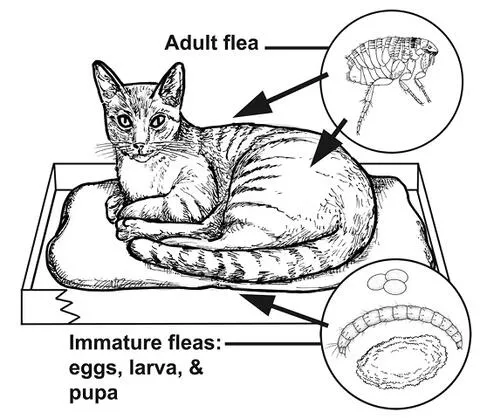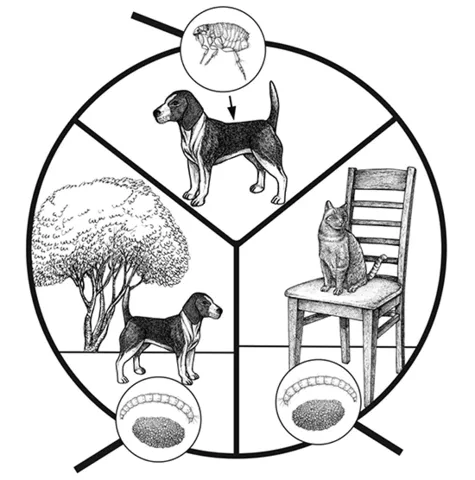Owning a dog or cat comes with the responsibility of managing fleas effectively. Even minor flea problems irritate pets, leading to itching and discomfort, while some animals suffer from flea allergy dermatitis due to bites. Severe infestations can weaken pets, cause anemia in puppies and kittens, and transmit tapeworms when pets swallow infected fleas during grooming. Though rare, humans—especially children—can get tapeworms from accidentally ingesting fleas. East of the Mississippi River, fleas rarely spread other human diseases, but their bites annoy people too. The cat flea (Ctenocephalides felis) dominates U.S. dog and cat infestations. Successful vet prescribed flea treatment for dogs requires targeting fleas on pets, indoors, and outdoors for comprehensive protection.
Comprehensive flea control breaks the life cycle across all environments. Keeping pets outdoors prevents indoor issues, but most owners prefer indoor access. Start by treating pets with vet-approved products. Pairing on-pet preventives with regular bedding cleaning stops fleas from spreading to homes or yards. Active infestations demand treating every stage everywhere.
 Magnified, detailed photo of a flea.
Magnified, detailed photo of a flea.
Understanding Flea Biology for Effective Control
Grasping flea life cycles is crucial for dog and cat owners battling infestations. Only adults live on hosts, feeding on blood. Females lay eggs that drop off into bedding or floors where pets rest. These tiny white eggs hatch in 2-6 days into larvae feeding on pet dander, flea feces, and dried blood—plentiful in pet areas.
 Life cycle of a flea, described in text under the heading Flea Biology.
Life cycle of a flea, described in text under the heading Flea Biology.
Fleas complete generations in as little as three weeks, with adults comprising just 5% of populations. Eggs, larvae, and pupae dominate, hiding in cracks, carpets, and shaded spots due to sunlight aversion and humidity needs. Larvae mature in 1-3 weeks, forming cocoons lasting weeks to months. Pupae detect hosts via vibrations and CO2, emerging when pets return—explaining sudden outbreaks in vacant homes.
Regular vacuuming and washing bedding disrupts this cycle. In my experience as a pet care expert, consistent hygiene halves reinfestations, per guidelines from entomology extensions like Mississippi State University.
Flea Treatments for Pets: Top Options for Dogs and Cats
Fleas thrive year-round but peak in warm months. Preventive on-pet products shield pets, families, and homes. Always check labels for species (dog vs. cat), ticks, internals, and safety—never use permethrin or amitraz on cats. Flea collars underperform; opt for topicals, orals, or prescription collars.
Here’s a summary of proven flea control products, drawn from veterinary recommendations:
| Product Name | Kills Adults | IGR | Application | Ticks | Key Ingredients | Dogs/Cats |
|---|---|---|---|---|---|---|
| Advantage | Yes | No | Topical | No | Imidacloprid | Both |
| K9 Advantix | Yes | No | Topical | Yes | Imidacloprid/Permethrin | Dogs |
| Advantage Multi | Yes | No | Topical | No | Imidacloprid/Moxidectin | Both |
| Bravecto | Yes | No | Oral | Yes | Fluralaner | Both |
| Capstar | Yes | No | Oral | No | Nitenpyram | Both |
| Comfortis | Yes | No | Oral | No | Spinosad | Both |
| Frontline Plus | Yes | Yes | Topical | Yes | Fipronil/Methoprene | Both |
| NexGard | Yes | No | Oral | Yes | Afoxolaner | Dogs |
| Revolution | Yes | No | Topical | Some | Selamectin | Both |
| Seresto | Yes | No | Collar | Yes | Imidacloprid/Flumethrin | Both |
| Trifexis | Yes | No | Oral | No | Spinosad/Milbemycin | Dogs |
| Vectra 3D | Yes | Yes | Topical | Yes | Dinotefuran/Pyriproxyfen/Permethrin | Dogs |
Popular picks include Frontline Plus for multi-stage control and Seresto collars offering 8 months of protection (reduced with frequent baths). Capstar provides rapid knockdown but short-term relief. For multi-parasite needs, Revolution or Trifexis excel.
Flea bites trigger allergies, similar to how dog allergy medicine addresses skin issues. Rotate products if resistance develops, and consult vets for puppies/kittens—treat moms pre-birth instead.
 Drawing of a cat in a bed with inset drawings of an adult flea and flea eggs, larva, and pupa.
Drawing of a cat in a bed with inset drawings of an adult flea and flea eggs, larva, and pupa.
Avoid over-application; match doses to weight. Heavy cases may need Capstar plus long-term topicals.
Indoor Flea Control: Cleaning and Treatments
Indoor fleas cluster in pet zones—carpets, bedding, furniture—where eggs and larvae thrive. Vacuuming weekly removes 95% of eggs/larvae and food sources, per extension studies. Wash bedding hot; discard bags sealed.
For sprays, combine adulticides (permethrin, pyrethrins) with IGRs (methoprene, pyriproxyfen) disrupting development. Avoid foggers—they miss crevices. Target cracks, under furniture.
| Active Ingredient | Examples |
|---|---|
| Bifenthrin + Zeta-Cypermethrin | Ortho Home Defense |
| Deltamethrin | Enforcer BugMax |
| Nylar + Permethrin | Enforcer Flea Spray |
| Methoprene + Permethrin | Adams Home Spray |
Follow labels strictly—no food areas, observe re-entry. For heavy infestations, treat every 2 weeks post-cleaning. Post-control, use pets as “traps” with on-pet treatments.
Professionals help but require your prep. Fleas mimic respiratory woes, like home remedies for sneezing dog.
Key steps:
- Treat pets.
- Vacuum/wash thoroughly.
- Spray adulticide + IGR.
- Repeat 14 days x2.
Outdoor Flea Control in Yards and Landscapes
Yard fleas signal infested pets or wildlife. Fence strays; limit outdoor feeding. Focus shaded pet rests—porches, shrubs—not sunny lawns.
| Active Ingredient | Examples | Rate/1000 sq ft |
|---|---|---|
| Bifenthrin + Zeta-Cypermethrin | Ortho BugClear | 6 fl oz |
| Dinotefuran | Alpine WSG | 10 g/gal |
| Permethrin | Hi-Yield 38% | 0.4-0.8 fl oz/gal |
| Bifenthrin Granules | Ortho Bug-B-Gon | 0.6-2.3 lb |
Liquids outperform granules; reapply 7-10 days. Check labels for sites.
 Drawing of a dog in a yard, a cat on a chair inside, and flea adult, eggs, and larva.
Drawing of a dog in a yard, a cat on a chair inside, and flea adult, eggs, and larva.
Conclusion: Maintain Flea-Free Pets and Home
Integrated flea control—pets, indoors, outdoors—breaks cycles effectively. Prioritize preventives, hygiene, and targeted treatments for healthy dogs and cats. Consult vets for tailored advice, especially allergies or breathing issues like medicine to help dog breathe easier. Stay vigilant year-round.
References:
- Mississippi State University Extension Publication 2597 (POD-12-23).
- USDA National Institute of Food and Agriculture.
- Veterinary product labels from manufacturers like Elanco, Boehringer Ingelheim.
